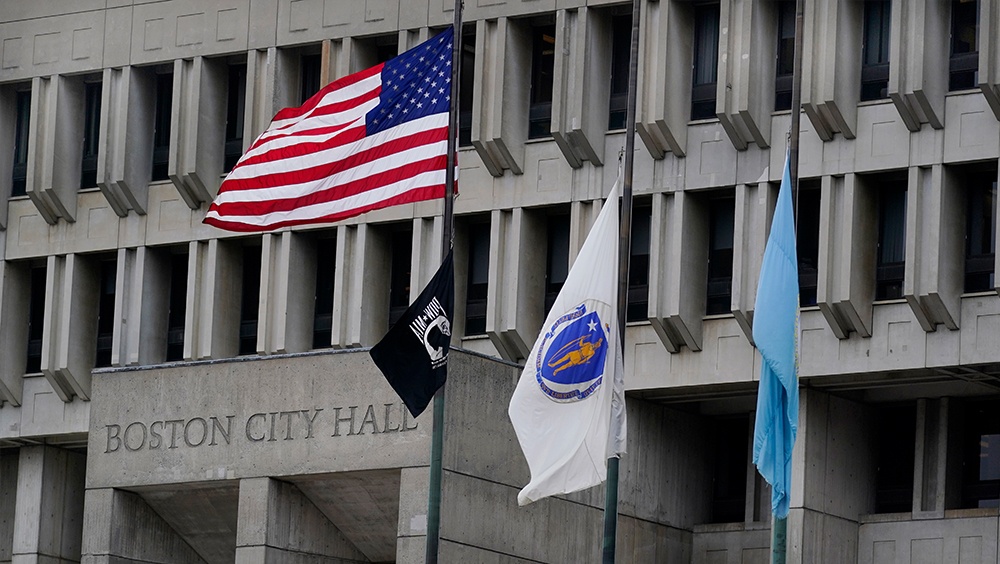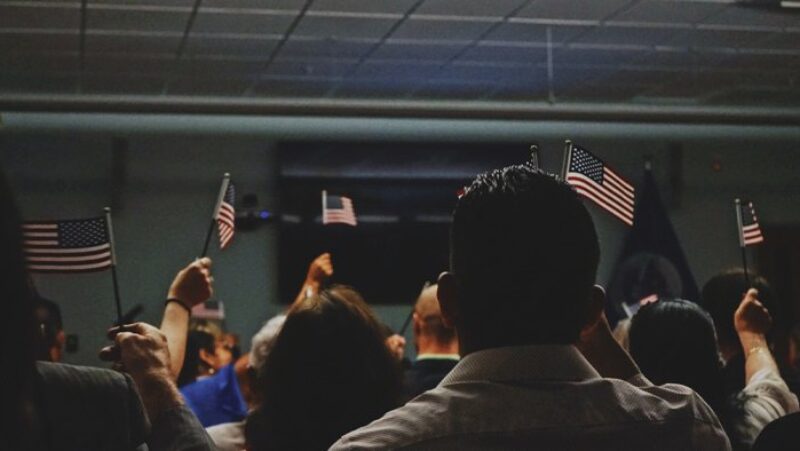Does the Government Have the Same Free Speech Rights as Everyone Else?

The government speech doctrine is an important concept in First Amendment law. It recognizes that the government often has an interest in contributing its own message or supporting certain ideas without opening itself up to a First Amendment free for all.
The government speech doctrine can serve as a powerful defense. If speech is classified as government speech, then the government is immune from First Amendment review.
When does the government speech doctrine apply?
The government sometimes raises the government speech doctrine when it is faced with a First Amendment lawsuit. The case of Shurtleff v. Boston (2022) is instructive. Harold Shurtleff sought to display his Constitution Camp flag on a flagpole outside Boston City Hall, pictured above. Boston city officials had allowed hundreds of groups to fly their flags on the flagpole but balked when Shurtleff sought to fly his organization’s flag.
The city denied the request because of the religious content of Shurtleff’s flag, which conveyed Christianity. He then sued the city, alleging unlawful viewpoint discrimination. Both a federal district court and a federal appeals court ruled in favor of the city, finding the flagpole to be a form of government speech.
RELATED: Everything to know about separation of church and state
However, Shurtleff appealed to the U.S. Supreme Court, arguing that the city had allowed a variety of flags to fly. The court agreed and found that the flagpole was not government speech. Justice Stephen Breyer explained: “Our past cases have looked to several types of evidence to guide the analysis, including: the history of the expression at issue; the public’s likely perception as to who (the government or a private person) is speaking; and the extent to which the government has actively shaped or controlled the expression.”
Key to the court’s decision was that the city had, by policy and practice, allowed all sorts of different flags to be flown on its flagpoles. It had not exercised editorial control but instead had ceded control to various private groups.
How does the government use government speech?
Though the Supreme Court did not specifically define it as a government speech case, Rust v. Sullivan (1991) provides an example of how the government relies on the doctrine. In that decision, the court narrowly upheld a gag rule of sorts, in the form of a Health and Human Services regulation prohibiting medical doctors who receive federal funds for health planning services from discussing the option of abortion with their patients.
The government was defending its priority of providing family planning services but wanted to specifically exclude abortion as an option. In other words, the government argued that it could empower physicians to discuss medical opinions – but not abortion.
The majority agreed with the government, explaining that “[t]he Government can . . . selectively fund a program to encourage certain activities it believes to be in the public interest, without at the same time funding an alternate program which seeks to deal with the problem in another way.”
How did the government speech doctrine come about?
The court declared that a beef marketing program that the government compelled beef producers to participate in was a form of government speech in Johanns v. Livestock Marketing Association (2005). But the court did not discuss the government doctrine other than to write that “the government sets the overall message to be communicated and approves every word that is disseminated.”
The Supreme Court’s first extensive examination of the government speech doctrine occurred in Pleasant Grove City v. Summum (2009). The case involved Utah city officials refusing to place a religious monument offered by the religion of Summum. Those with Summum accused the city of engaging in viewpoint discrimination. Their argument was that the city allowed the placement of a Ten Commandments monument associated with Christianity but denied a monument from Summum depicting “the Seven Aphorisms” of Summum.
On its surface, it seems as if the religion of Summum had a valid, free-speech claim. That is because the government seemed to favor Christian speech and disfavor the speech of Summum. But the Supreme Court ruled that a monument in a public park was a classic form of government speech. Writing for the court, Justice Samuel Alito explained that the “Free speech clause restricts government regulation of private speech; it does not regulate government speech.” Alito also acknowledged that there could be times where it is difficult to determine whether speech is governmental regulation of private speech or government speech. However, according to Alito, “permanent monuments displayed on public property typically represent government speech.”
What are some examples of government speech and times the government speech doctrine did not apply?
Government speech: specialty license plates
The Supreme Court next addressed the government speech doctrine and reached a sharply divided result in Walker v. Texas Division, Sons of Confederate Veterans Inc. (2015), a case involving specialty license plates. The Sons of Confederate Veterans in Texas had applied for a specialty license plate featuring an image of the Confederate Flag. However, the Texas Department of Motor Vehicles Board denied the request, stating that “many members of the public find the design offensive.”
RELATED: Are license plates free speech?
The case eventually reached the U.S. Supreme Court. A bare majority determined that specialty license plates are a form of government speech. Justice Stephen Breyer explained that specialty license plates are essentially a form of government identification. He also explained that with specialty plates, the government is highly involved in approving the design and look of such plates.
Justice Alito, who had written about the government speech doctrine in the monuments case, filed a dissent. He wrote:
“Here is a test. Suppose you sat by the side of a Texas highway and studied the license plates on the vehicles passing by. You would see, in addition to the standard Texas plates, an impressive array of specialty plates. … You would likely observe plates that honor numerous colleges and universities. You might see plates bearing the name of a high school, a fraternity or sorority, the Masons, the Knights of Columbus, the Daughters of the American Revolution, a realty company, a favorite soft drink, a favorite burger restaurant, and a favorite NASCAR driver.
“As you sat there watching these plates speed by, would you really think that the sentiments reflected in these specialty plates are the views of the State of Texas and not those of the owners of the cars?”
In other words, Alito explained that an average motorist upon viewing a specialty plate would associate the message from the plate more with the owner of the car than the government.
The court did explain that its decision was limited to specialty license plates rather than vanity plates. Most courts that have ruled on vanity plates have determined them to be private speech rather than government speech.
Not government speech: trademark registrations
The court also addressed the government speech doctrine in a case called Matal v. Tam (2017), a case in which a musician named Simon Tam sought to trademark the name of his Asian rock band called The Slants. The Patent and Trademark Office denied the trademark application, citing a provision of the Federal Trademark Act barring trademarks that “disparage” others.
Tam sued, alleging viewpoint discrimination. He pointed out that the intent of his band members was to take away the power of those who would utter slurs at Asian Americans. Ultimately, the case reached the Supreme Court. The government argued that trademarks were a form of government speech and thus there was no First Amendment violation.
The Supreme Court disagreed, finding that a trademark is private speech. Writing once again in this area for the court, Justice Alito explained:
“But while the government-speech doctrine is important — indeed, essential — it is a doctrine that is susceptible to dangerous misuse. If private speech could be passed off as government speech by simply affixing a government seal of approval, government could silence or muffle the expression of disfavored viewpoints. For this reason, we must exercise great caution before extending our government-speech precedents.”
The bottom line on government speech and the First Amendment
The government speech doctrine is a powerful doctrine in First Amendment law. If speech is deemed government speech, that ends the First Amendment claim. Justice Alito was correct when he warned that the doctrine is “important” but that it also “is susceptible to dangerous misuse.” Government officials could use this doctrine as an excuse to silence disfavored viewpoints.
David L. Hudson Jr. is a First Amendment fellow with Freedom Forum and an associate professor of law at Belmont University.
4 First Amendment ‘Where America Stands’ findings that surprised experts (and 3 that didn’t)
What Is Doxing and Is Doxing Illegal? Everything You Should Know
Related Content

